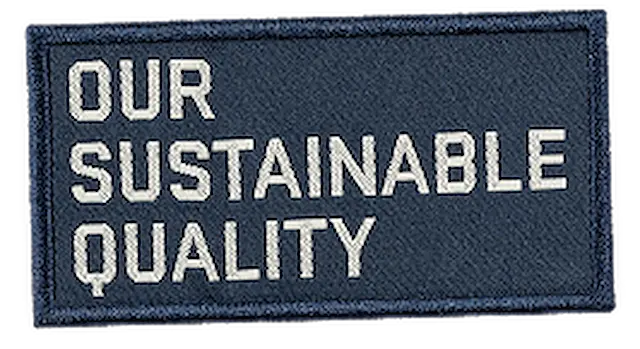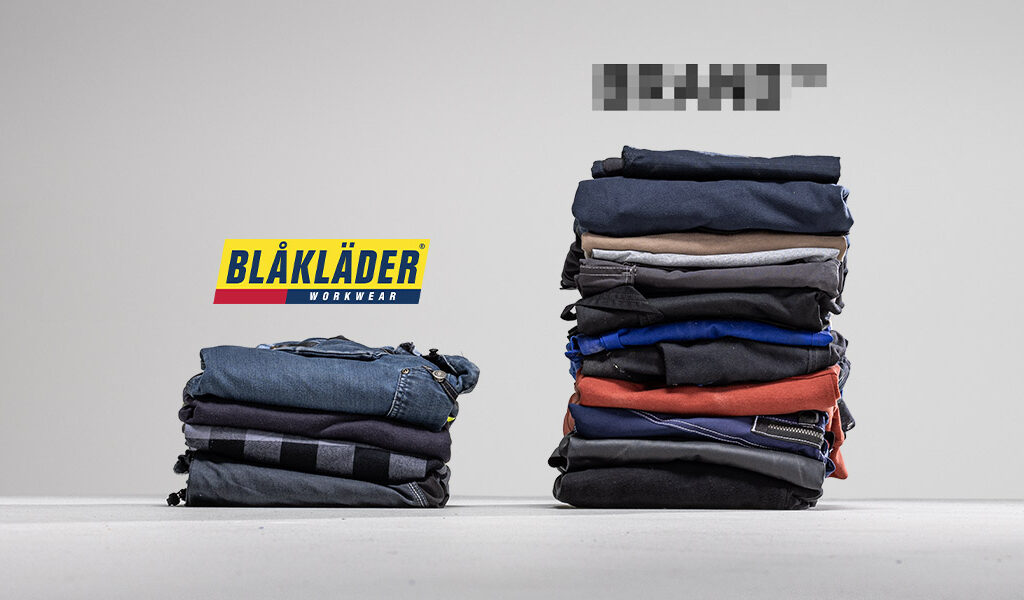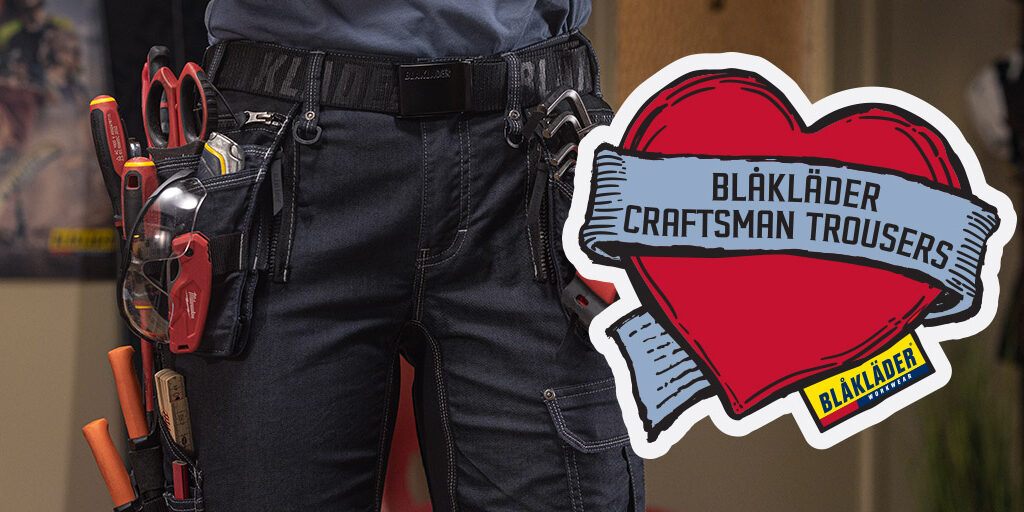
CLOTHES THAT LAST
Blåkläder workwear must be durable and long-lasting. That’s our business concept, but it’s also our main sustainability factor. Service life is therefore top of our designers’ minds when developing products and choosing the necessary materials. We have a lifetime guarantee on the seams and will help you get your garments repaired if they do end up needing it.
REFUSE
BUY FEWER GARMENTS
The world needs fewer garments. So as workwear manufacturers, we have only two choices: stop producing altogether – or make garments that are hard-wearing and meet tough sustainability standards. And here we are.
Reducing our climate impact starts with fewer garments.
The garment industry has a huge impact on the climate, causing high consumption of natural resources and emissions to land, sea and air. The scale of the impact depends on different variables in the manufacturing process, but the main factor is the huge volumes of garments produced every year.
So, for the workwear industry to reduce its impact on the climate and the environment, we need to produce fewer garments overall. Now try to imagine how many people wear workwear on a daily basis. Not just tradespeople in work trousers, but also service staff, shop assistants, industrial workers and many others. That’s hundreds of millions of people, at least.
So how do you go about producing fewer garments? Simple. Make garments that can be worn for as long as possible. If they can last twice as long, you’ve effectively halved your climate impact. But for that to happen, each garment needs to be extremely durable. It also needs to stay comfortable and presentable long enough to be worn until it wears out.

What should you ask for as a buyer?
If you’re in the business of buying workwear, you might look at figures on the carbon emissions and water consumption of production to compare how sustainable different garments are. These are reasonable figures to consider. But to make sustainable choices, you also need to know how long the garment is expected to last. The really interesting metric is the climate impact per day of use.
What makes a garment durable?
We believe that buying a new garment should be a last resort. So we build durability into every detail. The fabrics are tested for the exact job they’ll be doing in the real world, while the clothing has reinforcements in all the right places, plus three-needle stitching that lasts a lifetime. And once they’ve been tested, we test them again. Too much? Maybe, but our garments are put under a lot of stress.
Unfortunately, making really durable garments has more of a cost for the climate. But if you wear your garment until it’s completely worn out, the total number of garments bought and made will be less. And fewer garments are better for the climate. We can help you calculate whether it’s kinder on your wallet too.
RETHINK
BUY THE RIGHT GARMENTS
Workwear needs to do the job. But the job it has to do can vary hugely. That’s why we have so many different models to match the kind of work you do and the amount of wear it’s going to be exposed to. A garment designed to withstand your particular challenges means you’re less likely to have to buy a new one. And we won’t have to make a new one either. Good for you, better for the planet and, on the whole, pretty sensible. So how do you buy the right garment?
The right workwear is important for both your safety and your comfort. If it doesn’t fit properly, it can affect the level of protection it provides, freedom of movement and how long it lasts. Clothing that fits well reduces wear, lasts longer and saves money.
The right trousers last longer
Because every professional has unique needs, we make sure we have almost a thousand different trouser styles and a huge range of sizes. You should always be able to find the clothes that allow you to do your job, instead of worrying about what you’re wearing.
Finding a fit that really works means we can reduce unnecessary wear and extend the garment’s lifespan. Clothes that fit badly are often thrown out before they’re worn out. Wearing the right size will avoid trouser cuffs dragging on the ground or trousers splitting at the crotch. Do your work trousers often rip or get holes in? Ask us if we have a more durable material or a model with reinforcements in the appropriate places. Small changes can make a big difference to both durability and performance.

You have an important role to play here. Don’t impulse-buy workwear! When the time comes to choose your next garment, don’t rush it. Let us help you to find the best fit for you and your job.
Look after your garments
We aim to minimise the impact of workwear on the climate, but we need your help. Looking after your garments, washing them according to the instructions and avoiding tumble dryers where possible will make them last longer. If something breaks or splits, repair it instead of throwing the whole thing away. Read more about how best to look after your workwear in our care guide and our repair guide.
Reduce the cost and carbon footprint, but keep the safety
One of our major customers required their hi-vis clothing to be at least class 2. Visibility and safety are something we’re really passionate about, but we also know that garments with combined certification have several advantages. By using a certified combination of a Class 1 upper garment with a Class 1 lower garment, you still achieve Class 2 with clothing that is easier to keep clean and has a longer lifespan. And at a lower purchase price. Using our combined certification system, we were able to help the customer achieve the right safety class, while saving them money and reducing their environmental impact.
REDUCE
LAUNDRY SERVICE
Dirty clothes wear out, so looking after your garments is a win-win for your wallet and the climate. It is particularly important to keep hi-vis clothing clean, as dirt reduces visibility and therefore safety. That’s why we work with selected partner laundries. The idea behind the laundry service is to make it easy to extend the life of your garments so you get the maximum value out of your workwear. We regularly collect soiled garments to be washed and, if necessary, repaired. After washing, we return them, clean and ready for the next working day.
We don’t like expensive leasing agreements and we don’t believe in attaching strings. But we do believe in high quality and satisfied customers. With Blåkläder’s laundry service, you own your workwear as usual and only pay for what you actually wash and the services and garments you use. That’s it.

The right wash for the right garment
Workwear needs to be prepared for tough conditions, so it also needs a little tough love in the wash. That’s why each wash is tailored to the garment’s material function and safety requirements.
We’re sure you like control as much as we do. So our customer portal gives you a full overview of the costs and statistics – from how many washes each garment has had, to who’s wearing what. This is how both you and we can make more sustainable choices when buying workwear. It’s easy to get all nerdy about it, so beware.
Our laundry service is extremely skilled at avoiding unnecessary wear and tear on both clothes and the climate. And that’s putting it mildly.
REPAIR
BLÅKLÄDER'S REPAIR SERVICE
Blåkläder’s workwear is made to be both hard-wearing and long-lasting. It doesn’t make sense for workwear to fall apart early, prompting new production and new emissions. We in the textile industry must start fixing the planet. And when the wear and tear finally takes its toll? Well, there’s the option of repairing and giving the garments a new lease of life.
We've repaired over 10,000 garments – because we believe in wearing out, not throwing out.
When buying new – fix the old
Your work trousers tell the story of thousands of hours of hard and exacting work. A tear or a broken zip is not the end, it’s just the beginning of a new stage. Patch, mend and show off your scars – they’re proof that you know what it means to do a hard day’s work.

To make extending the life of your garments easier, we’ve now opened the first Blåkläder Repair Service stations, and we plan to open more soon. You can hand in garments that need mending at the station and get them back fighting fit for another round. We want it to be easy to extend the life of workwear, and so reduce both its climate footprint and cost.
Next time you invest in new clothes, take your old ones to the shop for a refresh, and then alternate between new and repaired to maximise their lifespan. Blåkläder doesn’t make throwaway garments – they’re designed to be worn, torn and repaired – and worn again.
RECYCLE/RECOVER
RECYCLING
Workwear tends to be thrown away not because it has fallen out of fashion, but because it’s completely worn out. The most effective sustainability measure we can take is to ensure that garments last and remain comfortable and presentable for a long time. But durable and functional garments that are discarded when heavily worn and soiled are particularly challenging to recycle, which makes workwear the bad boy of textile recycling.
Workwear has to be made of technical fabrics, using mixed fibres and reinforcement, so that it lasts and protects the wearer. This can limit the options for recycling the textile. When the fabric of a garment has become contaminated with hazardous substances such as oil or chemicals – a not uncommon reality for poor old workwear – the most environmentally efficient way to deal with it currently is usually to send it for incineration with energy recovery.
We collaborate with our customers to find sustainable recycling solutions.
But the technology is moving fast. Blåkläder is involved in several research and development projects to find smarter ways to recycle workwear, ranging from local upcycling initiatives to groundbreaking science projects. From 2025, we’ll be taking things up another notch with new analyses, projects and collaborations around the world – focusing on chemical recycling and how we can use recycled materials.
Once one of our garments has served its time – and believe us, that can take many years – we need to make smart choices. If it can be recycled, we do so. If not, we make sure we deal with it in the best possible way for the environment. It’s not perfect, but it’s what we’re able to do right now.
Our initiative also involves working on projects and establishing take-back systems for handling and recycling. So far this is with selected customers only, but we aim to scale it up.

